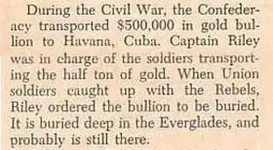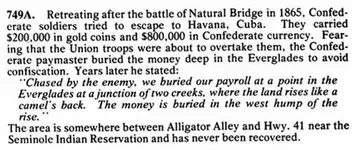Central Florida's role during the War of Northern Agression was mainly the supplier of beef,sugar,salt,clothing,and whiskey for the Confederacy by way of blockade runners along both coasts and the St Johns and Oklawaha rivers.The Union raided and burnt down the Confederate seasalt works at Cedar Key,and the plantation and sugar mill of David Yulee at Homosassa.
Ocala,in Marion county was a large supplier of goods and the home of John Matin, member of the Conferderate congress,and CSA Brig Gen Robert Bullock.
Jehu Foster Marshall had a large plantation at Sharpes Ferry on the Oklawaha River,( a small CSA redoubt,Ft Fowle was located just of his plantation)and was a major supplier of goods,including whiskey ,to the CSA,and shipped his wares by way of blockade runner Col. Hubbart L Hart's HARTLINE STEAMBOAT LINE,which navigated the Oklawaha from Silver Springs to Palatka on the St Johns River.Hart's riverboats,Hart's JAMES BURT or Capt Richard J Adams's SILVER SPRINGS, were also employed as transport for the calvary of Capt J J Dickinson (Marion county),for raids on the Union forces in Palatka and along the St Johns River,starting from Ft Brook (Orange Springs),or Davenport Landing.
Lola Sanchez,was a Confederate spy living in Union occupied Palata,and provided information on Union activities to both Hart and Dickinson.On May 22,1864,with information from Sanchez,Dickinson's calvary captured and later sunk the Union gunboat USS COLUMBINE,after removing arms,supplies,and a lifeboat.This is the only known event where a cavalry unit sank an enemy ship.
MARCH 10,1865-Marshall's plantation was raided by the 3rd UNION CLORED INFANTRY,led by SGT Major Henry James.This raid was repelled by Dickinson at Sharpes Ferry,and ended all Union activity in Marion county,the Oklawaha,and much of the west side of the St Johns.The yankees in Palatka,St Augustine,and Jacksonville refered to this part of Florida as "DIXIE".
APRIL 2,1865-Richmond fell and the Confederate treasury was dispatched in several directions.
THE OCALA/OKLAWAHA CONNECTION to THE LOST COFEDERATE TREASURY
The plan was to go south with the treasury and escape to either Mexico,Cuba,or the Bahamas.
CSA Sec of State Benjamin and CSA Sec. of War,John Breckinridge (once a VP of the USA)had friends in Ocala,John Martin and CSA Brig Gen Robert Bullock.With part of the treasury,gold bullion,gold coins,and Mexican silver dollars,all in wooden barrels,they made their way to Black Creek,a tributary of the St Johns,south of Union occupied ,Jacksonville,and loaded it on Hart's JAMES BURT.Lola Sanchez informed J J Dickinson,who was on board with his men,when it was safe to run past Palatka,and go down the Oklawaha to Silver Springs.A stopover was made at Ft Brook,where it is claimed some of the barrels were buried.Benjamin and Breckenridge stayed at Bullocks house in Ocala,and Dickinson gave them the USS COLUMBINE lifeboat,on top of a wagon,which they sailed to Cuba in.
So the questions remain:
Are there still barrels buried at Ft Brook? During Reconstruction is was used as a meeting ground by the Klan.
Where did the rest go?
Lola Sanchez recieved $500.00 in Mexican silver dollars for her help May 1865.
Hubbart L Hart was paid $4500.00 from the CSA to "clear" the Oklawaha of debris,May 1865,a river he used as a blockade runner.Hart expanded his steamboat line.
Dickinson moved from Marion county to south Florida ,where he purchased land for a new plantation.Quite a deal during Reconstruction.
Bullock became a member of the US HOUSE of REPRESENTATIVES.
Breckenridge made it to England from Cuba, wealthy,and returned to the US,where he was involved with many companies.
During the late 1950's,an old ODD FELLOWS HALL was torn down.Found during the demolition were several CSA artillery short swords and bundles of Confederate bills.



 Maybe I just dont know where to look? If anybody can help me find this story in military records I would really appreciate it.
Maybe I just dont know where to look? If anybody can help me find this story in military records I would really appreciate it. 



